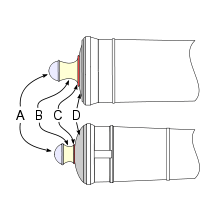Cascabel (artillery)


A cascabel is a subassembly of a muzzle-loading cannon - a place to attach arresting ropes to deal with the recoil of firing the cannon.
Description
A cannon's cascabel generally comprises the knob (A) and the neck (B), with particular models also featuring a filet (C). By some definitions, the cascabel additionally includes the base of the breech (D). Cascabels varied in design and appearance, and were a common feature of cannons from the 17th century until the advent of the breech loading cannon in the late 19th century.
Bronze cascabels from guns captured during the Siege of Sevastopol, once believed Russian-made and later shown to have been Chinese-made Russian captures, have been used to make all Victoria Cross medals.
References
Ripley, Warren (1984), Artillery and Ammunition of the Civil War, Charleston, S.C.: The Battery Press, p. 353
Manucy, Albert (1985), Artillery Through the Ages: A Short Illustrated History of Cannon, Emphasizing Types Used in America, Washington, D.C.: National Park Service, retrieved 2007-11-06 .
External links
| Wikimedia Commons has media related to Cascabel (artillery). |